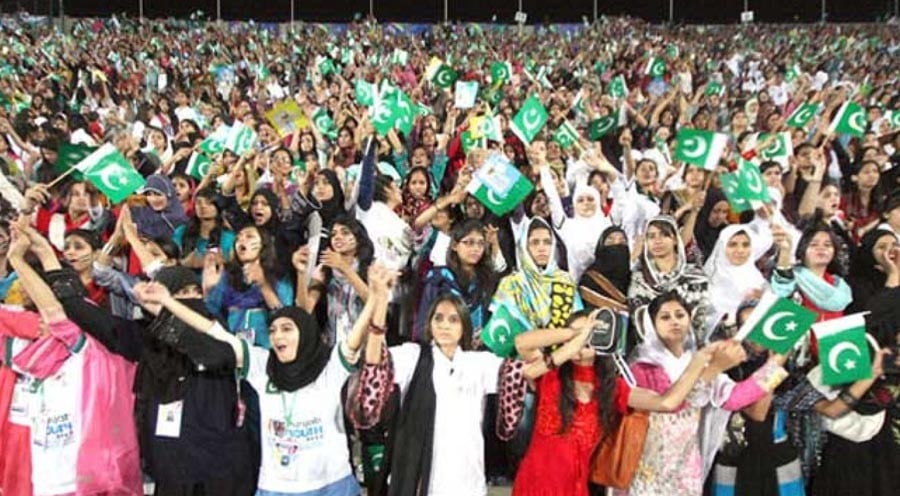
Are manifestoes of political parties contributing to youth’s socio-political and economic empowerment?

Pakistan is known to be an Orange country in the world, according to the United Nations that means a country comprising youthful population. The current census has shown 65 per cent of the population is below the age of 29 years and approximately 33 per cent between the age cohort of 15-29 years which is defined as youth age bracket by the government.
Youth bulge is a global phenomenon at the moment. Youth encompasses largest population -- 1.8 billion in the known history of mankind.
The pressing challenge is to convert this bulge into dividend by making progress in largely three domains of youth development and empowerment -- economic, social and political empowerment.
Youth development is a cross-cutting theme and requires a holistic approach. Youth is additionally composed of diverse categories, levels and sub fractions of youth population. We cannot define it as uniformed, single facet population.
Do manifestoes of political parties in Pakistan adhere to youth agenda as a holistic approach in their policy and planning or mere verbosity? Are political manifestoes offering youth to connect with socio-political and economic empowerment or just mobilising them to chant slogans for vested political purposes to show street power? As the voter age is reduced to 18 years, it has become an attraction for the political parties to know what they are offering to youth. Why youth should vote for them?
Performance of political parties can only be measured against agendas laid in their manifestoes. We have been witnessing political parties in this country are largely depending upon youth during their rallies, processions, sit-ins and gathering to show voters power and political warmth. Youth is largely at the mercy of political leaders to find their lost beacon of hope, emancipation as well as secured socio-economic lives.
All the main political parties, most of which are governing this country in different regions or have held governments in near past i.e.: Pakistan Muslim League-N (PML-N), Pakistan Tehrik-e-Insaf (PTI), Pakistan People’s Party (PPP), Mutahidda Qaumi Movement (MQM), and Awami National Party (ANP), have agendas for youth.
The PML-N manifesto has given a 7-point agenda on youth; the PTI 9 points; the PPP 9 points; the MQM 6 points and the ANP 6 points. The common election promises the parties have made are skill development, vocational training, entrepreneurship/employment, exchange programmes, scholarships, youth centers and rehabilitation against drug abuse.
All the manifestoes show inclination towards economic empowerment whereas social and political empowerment is largely missing. Youth are limited to only educated or school-going population ignoring other groups of those illiterate, rural, vulnerable youth, domestic workers, youth with special needs, youth from other religions etc. There is an obvious gap on gender equality/equity concept while defining youth. Manifestoes reflect only economic orientation, while perspective of social scientists and practitioners is missing.
It was found that manifestoes seem to be void of defining youth in a holistic manner, addressing youth issues other than economic. There is an obvious disconnect and vacuum between youth chapter of the manifestoes and empirical evidence and youth demography. The allocated half a page is just filled up with generic statements revolving around skills training, exchange programmes, loan schemes, youth centres etc.
Since youth is a new phenomenon brought to the governance domain after the 18th amendment, they need to have right space within policy framework as the youth pressure is gigantic which can’t be ignored any more.
The PPP has built the case of youth that gives a framework by linking it to the grass roots level networking -- entrepreneurship through banking, skills development through Shaheed Benazir Bhutto programme -- which could be expanded further. Whereas other manifestoes appear to be only wish lists.
The PTI has mobilised youth through Jawan Markaz, which is an efficient way to empower youth. The party has claimed to increase the number of skilled youth from 300,000 to two million.
The PML-N had promised special seats reserved for youth at Union Council (UC) and District Council level, which the party fulfilled by translating the promise into an act and allocating one youth seat per UC in Punjab followed by the Khyber Pakhtunkhwa government. The PML-N has also claimed "creating one million positions for apprenticeship in trade and industry, in collaboration with the private sector to ensure at least one job for every low income family."
Manifestoes are on a giving side trying to create everything within public sector -- they are government centered like socialist countries’ political agendas. There approach is government centered rather than creating opportunities by confining to the facilitation role. Consequently, it has become an attitude of the youth on other hand that they want everything to be provided by the government. The demand side is heavily relying on the government for their needs instead of finding avenues for social, political, economic uplift as an independent model without undue involvement of the government.
All the political parties spend million of rupees on Jalsas (rallies) during election campaign, but their manifestoes sound as wish lists prepared without giving proper time and resources, and lacking coordination with technical youth experts.